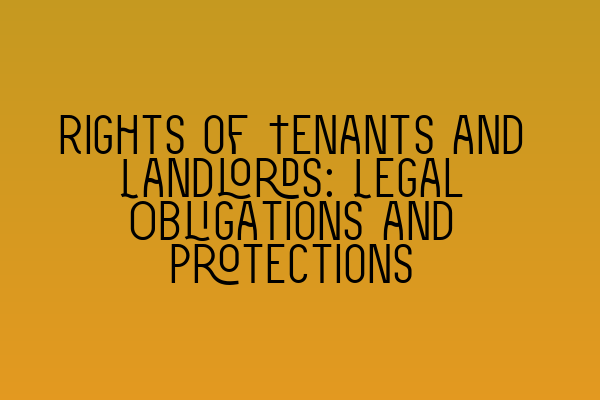Rights of Tenants and Landlords: Legal Obligations and Protections
As a solicitor at SQE Property Law & Land Law, it is crucial to have a solid understanding of the rights and obligations of both tenants and landlords. Renting a property can be a complex process, and it is essential to ensure that both parties are aware of their legal rights and responsibilities. In this blog post, we will explore the legal obligations and protections for tenants and landlords, providing valuable insights for a smooth tenancy experience.
1. Types of Tenancies:
Before delving into the legal obligations, it is important to understand the different types of tenancies. The most common types include Assured Shorthold Tenancies (AST), Assured Tenancies, and Excluded Tenancies. Understanding the type of tenancy in place will determine the rights and protections afforded to both tenants and landlords.
2. Tenant’s Rights:
Tenants have specific legal rights guaranteed by law to ensure they are protected throughout their tenancy. Some key rights include:
a) Right to a safe and habitable property: Landlords are legally obliged to provide a property that is safe, in good repair, and fit for habitation. This includes ensuring the property meets all necessary safety standards, such as gas and electrical safety certificates.
b) Right to privacy: Tenants have a right to enjoy their home without unnecessary interference from the landlord. Landlords must provide proper notice and obtain consent before entering the property, except in cases of emergency.
c) Right to be protected from unfair eviction: Tenants enjoy protection from unfair eviction. Landlords must follow the correct legal procedures, such as issuing proper notices and obtaining court orders, to evict a tenant. Illegal evictions can result in severe penalties for landlords.
d) Right to have their deposit protected: Landlords are legally required to protect tenants’ deposits in a government-approved tenancy deposit scheme. This ensures that tenants can have their deposit returned at the end of the tenancy, minus any agreed deductions.
To learn more about tenants’ rights and responsibilities, you can refer to our comprehensive guide on SQE Tenant’s Rights.
3. Landlord’s Obligations:
In addition to tenants’ rights, landlords also have several legal obligations that they must fulfill:
a) Obligation to provide a safe and habitable property: Just as tenants have the right to a safe and habitable property, landlords have an obligation to maintain the property in good repair and ensure it is safe for tenants to live in. This includes undertaking necessary repairs promptly and complying with all relevant health and safety regulations.
b) Obligation to protect the tenant’s deposit: Landlords must protect the tenant’s deposit in a government-approved tenancy deposit scheme within 30 days of receiving it. Failure to do so can lead to significant financial penalties for landlords.
c) Obligation to provide necessary documentation: Landlords are required to provide tenants with specific documentation, including a valid Energy Performance Certificate (EPC), an annual gas safety certificate (if applicable), and a copy of the “How to Rent” guide.
d) Obligation to respect tenants’ privacy: Just as tenants have the right to privacy, landlords must respect their tenants’ right to enjoy their home without unnecessary interference. Landlords must provide notice and obtain consent before entering the property, except in cases of emergency.
For a detailed breakdown of landlords’ obligations, we recommend referring to our article on SQE Landlord’s Obligations.
4. Legal Protections:
In addition to the aforementioned rights and obligations, both tenants and landlords benefit from legal protections provided by the law. These protections ensure that both parties have a fair and lawful tenancy.
Legal protections for tenants include protection against unfair eviction, protection of their deposit, protection against discrimination, and protection against retalitory actions by the landlord.
Legal protections for landlords include protection against non-payment of rent, protection against damage to the property, protection against illegal activities conducted on the property, and protection against breach of tenancy agreement.
Both tenants and landlords should be aware of these protections and seek legal advice if they find themselves in a situation where they need to assert their rights and protections.
In conclusion, understanding the rights and obligations of both tenants and landlords is crucial for a harmonious tenancy experience. Tenants have the right to a safe and habitable property, while landlords have the obligation to provide such a property and fulfill other legal obligations. Legal protections are in place to ensure fairness and equality for both parties. It is important to seek legal guidance from professionals like SQE Property Law & Land Law to navigate the complexities of tenancy law successfully.
For more information on the SQE exams and the preparation courses we offer, you can visit our related articles:
– SQE 1 Practice Exam Questions
– SQE 1 Practice Mocks FLK1 FLK2
– SQE 2 Preparation Courses
– SQE 1 Preparation Courses
– SRA SQE Exam Dates
Remember, having a strong understanding of rights and obligations is essential for both tenants and landlords to ensure a fair and lawful tenancy.
